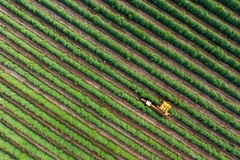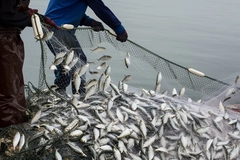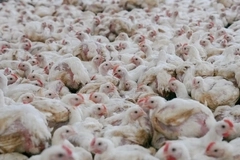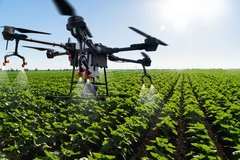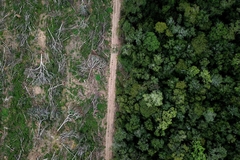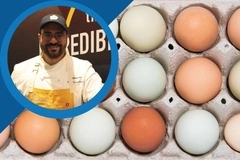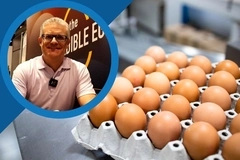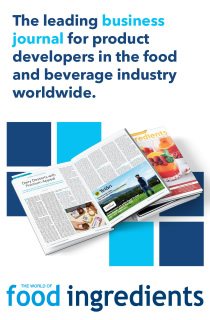Kerry partners with US scientists to examine digital tools for F&B waste challenges
 Kerry’s Emma Cahill and UGA’s Kevin E. Mis Solval presented a scientific poster from the study in Italy last month.
Kerry’s Emma Cahill and UGA’s Kevin E. Mis Solval presented a scientific poster from the study in Italy last month.Kerry and the University of Georgia (UGA) are examining shelf life extension as a strategy to reduce food waste and conserve resources at a time when globally, one-fifth of food produced for human consumption is lost or wasted, according to the UN’s World Food Program. Their collaborative research unlocks how digital tools like Kerry’s Food Waste Estimator help the F&B industry mitigate its waste reduction challenges by creating “actionable insights.”
The digital tool can inform brands and consumers on levels of food waste being experienced in specified categories while also indicating the benefits that actions to reduce food waste can have in terms of savings and reduced environmental impacts.
Food Ingredients First speaks with Emma Cahill, global strategic marketing director, Food Protection and Preservation at Kerry and UGA scientists Kevin E. Mis Solval, associate professor, Department of Food Science and Technology and Vondel Reyes, research professional, who conducted the study, to understand the impact of these tools in the F&B industry.
“Digital tools can help indicate starting points and value cases for shelf life extension projects. Kerry’s food waste estimator is a digitization of a range of data sources on regional and product-level food loss and waste statistics across all supply chain stages,” says Cahill.
 Nearly 14% of the world’s food is lost per year between harvest and retail market, says the FAO. “There is the ability to leverage custom data, where a user’s downstream waste is already known. With the input of specific information, outlined within the tool, it can be used to give an indication of the reduction in food waste.”
Nearly 14% of the world’s food is lost per year between harvest and retail market, says the FAO. “There is the ability to leverage custom data, where a user’s downstream waste is already known. With the input of specific information, outlined within the tool, it can be used to give an indication of the reduction in food waste.”
The team showcased the research at the International Union of Food Science and Technology Congress, which was held in Rimini, Italy, last month.
Pressure to cut waste
A pressing need to reduce waste and its environmental impact inspired UGA’s team to develop the food waste estimator, Solval shares.
“The growing demand for sustainable solutions in the F&B industry, alongside the potential for shelf life extension to minimize waste, motivated the creation of this practical tool.”
F&B manufacturers can benefit from the study’s insights into sustainable practices, such as extending shelf life through innovative preservation techniques.
“These practices may reduce waste, improve product quality, and increase profitability. By adopting these strategies, manufacturers can meet consumer demand for longer-lasting, eco-friendly products while also reducing environmental impact,” he continues.
Why extend shelf life?
Extending shelf life can increase nutritional reach (consumers nourished per kg of food) and reduce downstream food waste, observes Cahill. It also reduces delivery frequency, increases distribution range, reduces labor for shelf turnover and the frequency of consumer grocery trips.
 Kerry’s Food Waste Estimator has received positive reactions from the market and the research community, says Cahill.A longer shelf life also “increases brand loyalty, increases market share and improves consumer perception,” she adds.
Kerry’s Food Waste Estimator has received positive reactions from the market and the research community, says Cahill.A longer shelf life also “increases brand loyalty, increases market share and improves consumer perception,” she adds.
Meanwhile, UGA’s Solval believes food waste and shelf life extension are “linked.” Extending the shelf life of food products reduces spoilage, which in turn minimizes waste.
“Techniques like packaging innovations and preservation technologies slow food degradation, ensuring that food remains safe and consumable for longer periods and directly addresses food waste challenges.”
Additionally, in regions where downstream food waste is statistically highest due to factors like consumer behaviors, climate, and supply chain inefficiencies, the impact of extra shelf life days can be more pronounced, resulting in greater environmental benefits.
Supporting food security
The findings, published in Sustainability, state that wasted food can potentially alleviate global hunger, linking food waste directly to food insecurity.
With the global population expected to reach 8.5 billion by 2030 and over 864 million people experiencing severe food insecurity, addressing this issue is crucial, notes Kerry.
 The waste estimator will enable food manufacturers to improve resource efficiency, lower cost and meet sustainability goals, says Reyes.“The Kerry Food Waste Estimator empowers both manufacturers and consumers to make impactful decisions that significantly reduce food waste and drive sustainability forward,” says Cahill.
The waste estimator will enable food manufacturers to improve resource efficiency, lower cost and meet sustainability goals, says Reyes.“The Kerry Food Waste Estimator empowers both manufacturers and consumers to make impactful decisions that significantly reduce food waste and drive sustainability forward,” says Cahill.
“With UGA’s validation, this tool highlights how shelf life extension positively impacts conserving the environment and advancing food security.”
The tools have received positive reactions from the market and the research community. F&B manufacturers are using them to fuel business cases for shelf life extension internally and to downstream retailers, she adds.
Bridging science and practical applications
For Reyes, the findings bridge scientific expertise with real-world industry applications, “driving meaningful change to increase global food security and sustainability.”
To understand the food waste estimator’s practical applications, the researchers investigated its use in the poultry and bread manufacturing industries.
Findings revealed that extending poultry meat’s shelf life by 40% can reduce waste by 6-7%, lower CO2 emissions and save 660,000-810,000 liters of water per metric ton.
Meanwhile, extending bread’s shelf life by 20% can cut waste by 5-6%, reduce CO2 emissions by 160-190 kg, and conserve 250,000-310,000 liters of water per metric ton.
“Our team chose poultry and bread products because they are widely consumed and represent two critical categories in food waste: perishable protein-rich foods and staple carbohydrate products,” Reyes tells us.
 By increasing the shelf life of poultry meat by 40%, waste could be reduced by 6–7%, states the study.“These items have distinct spoilage mechanisms, making them ideal for studying shelf life extension strategies, which could have broad applications across food sectors.”
By increasing the shelf life of poultry meat by 40%, waste could be reduced by 6–7%, states the study.“These items have distinct spoilage mechanisms, making them ideal for studying shelf life extension strategies, which could have broad applications across food sectors.”
Overcoming data challenges
During the study, the researchers faced several challenges due to the lack of comprehensive data on life cycle assessments for poultry and bread products, Reyes continues.
“That data was vital to accurately model the complex factors influencing spoilage, such as microbial growth and packaging variations.”
“In addition, this knowledge gap made it difficult to accurately assess the environmental impact of waste reduction strategies and shelf life extension, limiting the ability to evaluate the sustainability of proposed interventions fully.”
However, the team identified the proper databases and resources to accurately study poultry and bread products.
For Cahill, the challenges faced also supported the case for the food waste estimator’s need.
“Data in this area is limited, whether global or regional and sourced with varying degrees of confidence and consistency. Even foods CO2 and water equivalents saw some variation across different databases and source references.”
Driving innovation
When asked if similar food waste estimation tools exist, Cahill tells us about “a food loss and waste protocol” and a test version of a calculator online from the World Resources Institute that allows users to see their waste’s carbon equivalent.
 Kerry has recently launched a bakery shelf life model tool that allows users to identify ingredients and dosage for additional shelf life days.“As part of the journal article research partnership, no equivalent calculators were found to exist.” Kerry’s calculator is “free to use” and may drive other companies to develop similar tools more tailored to their industry, she adds.
Kerry has recently launched a bakery shelf life model tool that allows users to identify ingredients and dosage for additional shelf life days.“As part of the journal article research partnership, no equivalent calculators were found to exist.” Kerry’s calculator is “free to use” and may drive other companies to develop similar tools more tailored to their industry, she adds.
Meanwhile, the company has recently launched a “bakery shelf life model” tool that allows users to identify ingredients and dosage to achieve additional shelf life days in the application, she reveals.
She expects food waste tackling innovations to be truly sustainable in the future.
“We see the industry critically assessing the sustainability of solutions such as freezing and high-pressure processing. The industry is looking closely at whether the cost, capital investment, logistical challenges and carbon footprint set them up for long-term growth with consumers and their own sustainability goals.”
